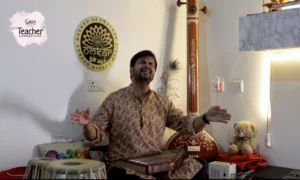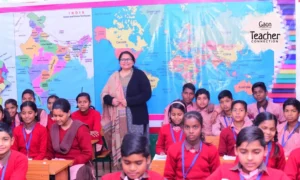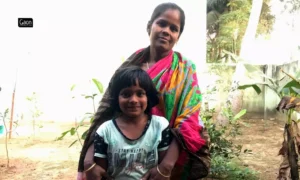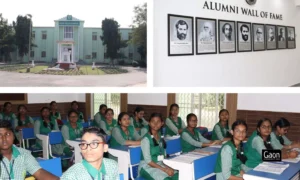Kunaura (Lucknow), Uttar Pradesh
Kushma Devi, dressed in navy blue kurta, white salwar and matching dupatta, is busy fixing her desktop computer, plugging mouse and keyboard wires into the CPU. Her hair oiled and neatly braided, the 17-year-old opens Canva – a graphic designing platform – on her computer.
It is the festival season with Diwali just around the corner, and the class 12 student of Bharatiya Gramin Vidyalaya in Kunaura panchayat, about 40 kilometres from the state capital Lucknow, has a large number of posters to design.
What will you design? The Canva website asks Kushma.
She quickly searches for copyright-free pictures and downloads a free picture of a colourful butterfly feasting on yellow pollen.
“Do you like butterflies?” asked the Gaon Connection reporter.
“Yes”, came a quick reply. “Because they can go anywhere they want to!”
And Kushma is also raring to go.
The 17-year-old, who hails from Durjanpur village in Lucknow district, is one of the students in Bharatiya Gramin Vidyalaya, a rural school that is breaking barriers and imparting modern skills to its students using the Internet and latest technology.
As part of a novel initiative, a skill centre at this rural school is imparting training to village students in graphic designing, Swayam Skill Centre. Kushma wishes to become a graphic designer, a job profile no one in her village is aware of, but is in high demand in the outside market.
“We are learning how to download pictures using pixabay. Select poster, give headline, change colour, font, and make poster on Canva,” said Kushma cheerfully. “I enjoy making posters. I do not want to do silai kadhai (stitching and embroidery work),” she added. More than 15 students, including rural girls, are learning the basics of graphic designing at the school.
“When girls in villages go to school they are told you have to do chauka bartan (manage kitchen chores). I was also told the same. Now when I make posters, I think I can do something different,” Mohini Singh, a class 12 student, told Gaon Connection. “People in my village say that we girls cannot do anything. I want to prove them wrong by learning to design posters,” she added.
Leading this initiative is SB Misra, a geologist and founder of Bharatiya Gramin Vidyalaya, who started this school in 1972.
“After conventional education till class twelfth, students wander aimlessly in cities for jobs. We have set up a skill centre and initiated new courses so that they learn skills in different areas for instance, tally, housekeeping, camera [photography], repairing (mobile and computer), triple C [CCC or Course on Computer Concepts], SB Misra told Gaon Connection. “This is how these rural students will develop confidence and compete with their urban counterparts,” the school manager added.
“Rural kids are unable to compete with urban kids because they lack learning opportunities. If we provide those opportunities, then they can compete with anyone. I believe if other schools also equip themselves with technology and modern methods then rural education will gallop forward,” added the octogenarian as he adjusted his hearing aid.
Also Read: A farewell to alms as little hands that once begged now hold notebooks to read and write
Breaking stereotypes
Located at the heart of Uttar Pradesh, Bharatiya Gramin Vidyalaya aims to make rural students self-reliant through quality education imparted using the latest technology. To manage the activities of the school, there is a management committee which contributes to the progress of the school.
Neelesh Misra, founder of Gaon Connection, India’s biggest rural media platform, who is Vice President of the management committee of the school, believes that there are stereotypes related to youth from a rural background.
“There are stereotypes on what should be taught to rural children. If you open a skill centre, one would think to train them in carpentry and farming or anything related to physical labour,” Neelesh Misra told Gaon Connection. “Although there is no problem in that, rural youth get limited to these choices, because we have stereotypes about them. The initiative [skill centre] would help break these stereotypes,” he added.
“In the time when India’s media industry is booming and everyone needs graphic designers, can rural kids help in that?” asked the vice president of the management committee adding: “Our small initiative can be a hope for hundreds of schools in villages. This is not a small change. It will impact generations.”
Also Read: A ‘smart’ decision enables visually challenged students to enjoy their studies
When life comes full circle
And who knows it better than Faraz Husain. The 21-year-old graphic designer passed out of Bharatiya Gramin Vidyalaya and now works with Gaon Connection. Husain is voluntarily teaching poster making to students at his alma mater. Not just Husain, even his father studied at the same school in Kunaura.
“I have studied in this school till my twelfth class. And now I have got an opportunity to teach kids in my own school,” Husain said smilingly. “Most of these rural kids do not know what they have to do [in career]. They do not have guidance. I faced a similar situation and then went to the city and learnt graphic designing,” he told Gaon Connection.
While Husain spoke with Gaon Connection, Jitendra Kumar, another student in the computer lab, was busy making posters for Diwali and book covers on Canva. “It’s been only a couple of days that he touched the computer and started designing posters, but he has learnt quickly,” said Husain proudly.
“I used to feel that I would not be able to touch a computer in my life and would not be able to do anything in my life. Now we are making posters. It gives me confidence and hope,” Jitendra told Gaon Connection.
According to Neelesh Misra, there is a massive change that is lying at the heart of this small effort at Bharatiya Gramin Vidyalaya. “It was for the first time (on October 4) that these children touched the computer in their lives. It is a very sharp learning curve. They have learnt very quickly. This gives me hope that there can be a change,” he said.
‘Began virtual classes way before the world did’
Apart from the Swayam Skill Centre, what sets Bharatiya Gramin Vidyalaya apart is its virtual class centre equipped with a projector, a microphone, a projection screen and high speed Internet.
On October 13, when Gaon Connection visited the school, a virtual class was going on. Sitting on the neat carpeted floor, a girl was reading a passage from her textbook: “Most of the poor live in villages, rather most of the people, in India, live in villages, not in cities.”
The virtual teacher, Charu Tandon, a volunteer based in Chandigarh, about 800 kilometres from Kunaura, was teaching kids about ‘Equitable distribution of resources’.
Much before the COVID19 pandemic forced shutdown of educational institutes and made online learning a norm, Bharatiya Gramin Vidyalaya started long-distance online classes in 2019.
“The internet has reached villages. Rural kids want to learn new things, and there are teachers in urban areas who want to teach them. We are trying to make that connection through the Internet and virtual classrooms,” said Neelesh Misra. “When we started the virtual classes, this was the first school worldwide to impart education to kids through these classes daily,” he added.
Volunteers from India to the United Arab Emirates teach these students English, Physics, Mathematics and tell them about their experiences. A classroom of 20 students with a 1:1 ratio of young boys and girls, study in this virtual classroom.
“I like both online and physical [face-to-face] classes, but I like online classes more. These teachers share their experiences of cities and we learn from their experiences,” the class 12 student Mohini Singh said.
“Be it teaching graphic designing, video and sound editing, Physics and English classes, we want to make this school the first school in India to have most of the virtual classes and supplement face to face classes. I think this initiative can help address the gap in the education system of rural schools,” said Neelesh Misra.
Also Read: An element of fun: School students in Satna no more troubled by the periodic table



















